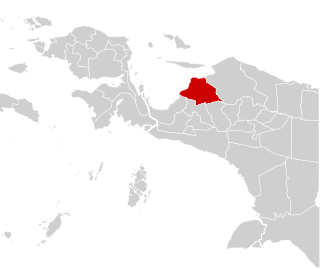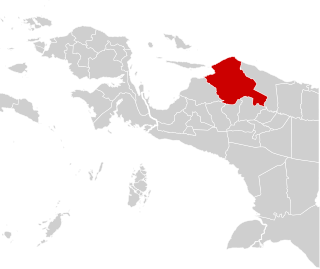
Papua is a province of Indonesia, comprising the northern coast of Western New Guinea together with island groups in Cenderawasih Bay to the west. It roughly follows the borders of Papuan customary region of Tabi Saireri. It is bordered by the sovereign state of Papua New Guinea to the east, the Pacific Ocean to the north, Cenderawasih Bay to the west, and the provinces of Central Papua and Highland Papua to the south. The province also shares maritime boundaries with Palau in the Pacific. Following the splitting off of twenty regencies to create the three new provinces of Central Papua, Highland Papua, and South Papua on 30 June 2022, the residual province is divided into eight regencies (kabupaten) and one city (kota), the latter being the provincial capital of Jayapura. The province has a large potential in natural resources, such as gold, nickel, petroleum, etc. Papua, along with five other Papuan provinces, has a higher degree of autonomy level compared to other Indonesian provinces.

West Papua, formerly Irian Jaya Barat, is a province of Indonesia. It covers the two western peninsulas of the island of New Guinea, the eastern half of the Bird's Head Peninsula and the Bomberai Peninsula, along with nearby smaller islands. The province is bordered to the north by the Pacific Ocean, to the west by the Halmahera Sea and the Ceram Sea, to the south by the Banda Sea, and to the east by the province of Central Papua and the Cenderawasih Bay. Manokwari is the province's capital and largest city. West Papua is the second-least populous province in Indonesia. It had a population of 1,134,068 at the 2020 Census, and the official estimate for mid 2022 was 1,183,307. However the total area and population was reduced by the Parliamentary decision on 17 November 2022 to create a 38th province of Indonesia, comprising Sorong city and the regencies of Sorong, South Sorong, Raja Ampat, Maybrat and Tambrauw; this new province, called Southwest Papua, came into existence from 8 December 2022. The reduced West Papua Province thus had a mid-2022 population estimated at only 561,403.

The East Geelvink Bay or East Cenderawasih languages are a language family of a dozen Papuan languages along the eastern coast of Geelvink Bay in Indonesian Papua, which is also known as Sarera Bay or Cenderawasih.
The Lower Mamberamo languages are a recently proposed language family linking two languages spoken along the northern coast of Papua province, Indonesia, near the mouth of the Mamberamo River. They have various been classified either as heavily Papuanized Austronesian languages belonging to the SHWNG branch, or as Papuan languages that had undergone heavy Austronesian influence. Glottolog 3.4 classifies Lower Mamberamo as Austronesian, while Donohue classifies it as Papuan. Kamholz (2014) classifies Warembori and Yoke each as coordinate primary subgroups of the South Halmahera–West New Guinea languages.

The Yawa languages, also known as Yapen languages, are a small family of two closely related Papuan languages, Yawa and Saweru, which are often considered to be divergent dialects of a single language. They are spoken on central Yapen Island and nearby islets, in Cenderawasih Bay, Indonesian Papua, which they share with the Austronesian Yapen languages.

The South Halmahera–West New Guinea (SHWNG) languages are a branch of the Malayo-Polynesian languages, found in the islands and along the shores of the Halmahera Sea in the Indonesian province of North Maluku and of Cenderawasih Bay in the provinces of Papua and West Papua. There are 38 languages.

Cenderawasih Bay, also known as Sarera Bay and formerly Geelvink Bay, is a large bay in northern Province of Papua, Central Papua and West Papua, New Guinea, Indonesia.
The Baropasi or Barapasi language is a member of the East Geelvink Bay languages. It is spoken in Upper Waropen District, Mamberamo Raya Regency, Papua, Indonesia. It has about 1,000 speakers.

Waropen Regency is one of the regencies (kabupaten) in Papua Province, Indonesia. The Regency covers an area of 10,847.97 km2, and it had a population of 24,639 at the 2010 Census and 33,943 at the 2020 Census. The official estimate as at mid 2021 was 34,414. The capital is the town of Botawa.

Mamberamo Raya Regency is one of the regencies (kabupaten) in Papua Province, Indonesia; it was created on 15 March 2007 from parts of Sarmi Regency and Waropen Regency. It covers an area of 23,813.91 km2, and had a population of 18,365 at the 2010 Census which had virtually doubled to 36,483 at the 2020 Census. The official estimate as at mid 2021 was 36,989. The administrative centre is at Burmeso.
Awera is a Lakes Plain language of Papua, Indonesia. It is spoken on the east side of Geelvink Bay, in the single village of Awera in Wapoga District, Waropen Regency, Papua. The village has a majority of Ansus (Austronesian) speakers.
Waropen is an Austronesian language spoken at the Geelvink Bay of Indonesian Papua. It is fairly closely related to the Yapen languages. Dialects are Waropen Kai, Napan, and Ambumi.
Woria is a nearly extinct Papuan language of the Indonesian province of Papua, on the eastern shore of Cenderawasih Bay. It is spoken in Botawa village, Waropen Regency, where the Lakes Plain language Saponi was also spoken.
Tefaro is a Papuan language of the Indonesian province of Papua, on the eastern shore of Cenderawasih Bay. It is spoken in Demba and Tefaro villages of Waropen Regency.
Burate is a Papuan language of the Indonesian province of Papua, on the eastern shore of Cenderawasih Bay. The specific areas that the Burate language is spoken in include the Papua Provence, the Wapoga river mouth, one village of the Waropen Bawah subdistrict, and the Yapen Waropen regency.
Sauri is a Papuan language of the Indonesian province of Papua, on the eastern shore of Cenderawasih Bay. It is spoken in Sauri-Sirami village, Masirei District, Waropen Regency.

Central Papua, officially the Central Papua Province is an Indonesian province located in the central region of Western New Guinea. It was formally established on 11 November 2022 from the former eight western regencies of the province of Papua. It covers an area of 61,072.92 km2 and had an officially estimated population of 1,430,951 in mid 2022. It is bordered by the Indonesian provinces of West Papua to the west, province of Papua to the north, and by Highland Papua and South Papua to the east. The designated administrative capital is located in Nabire Regency.
Yaur is an ethnic group who inhabit the northern coastal area of Nabire Regency precisely in Yaur District. The area inhabited by the Yaur people is included in the Saireri customary territory which includes the northern coast of Nabire, Biak Islands, and Yapen Island.









